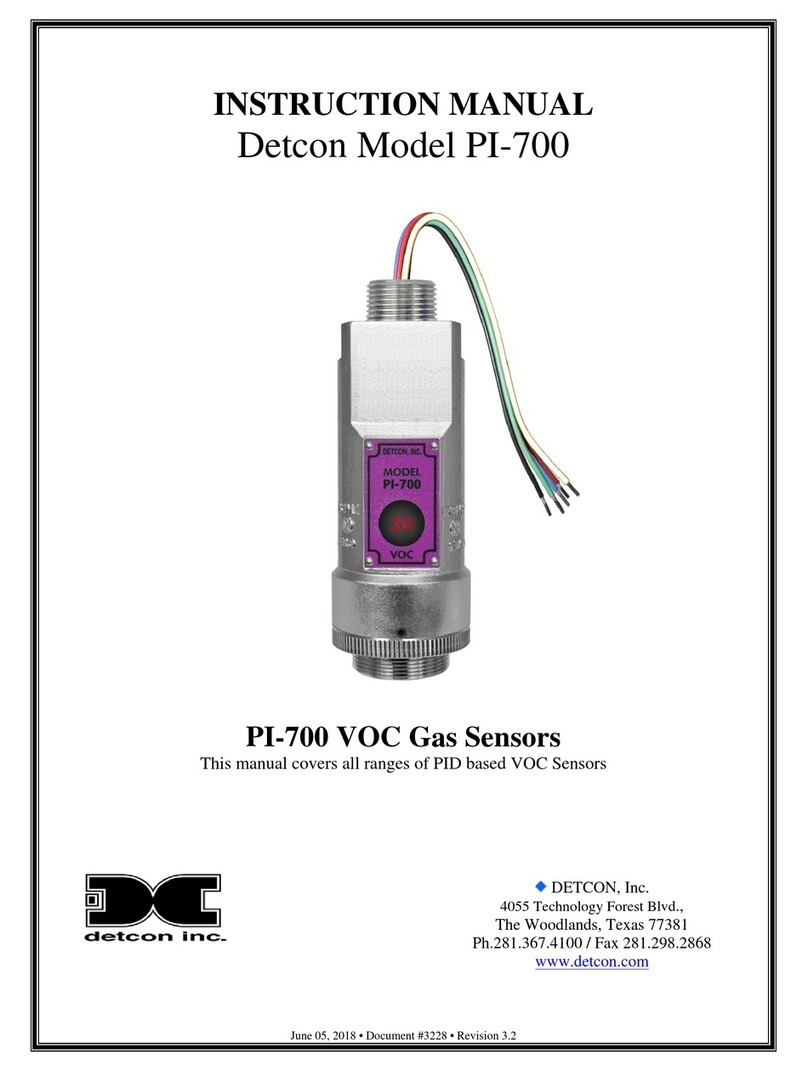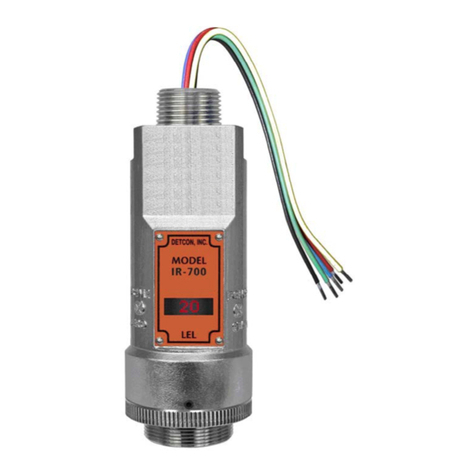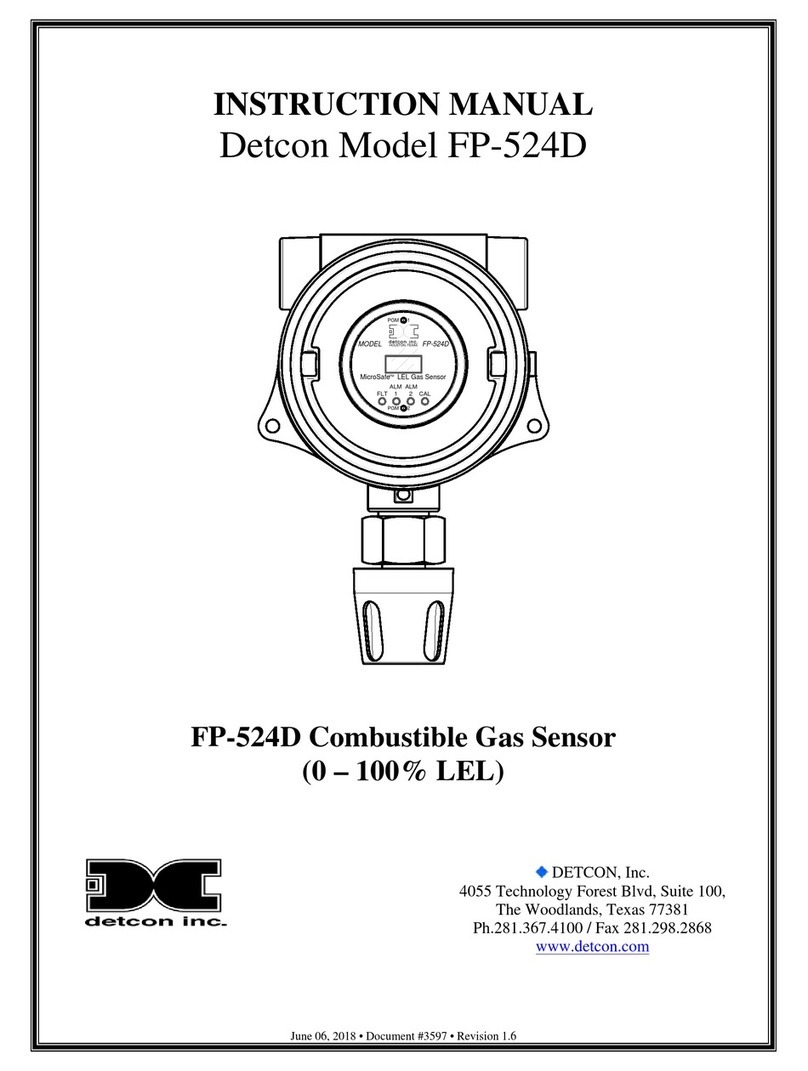Detcon TP-524D User manual

INSTRUCTION MANUAL
Detcon Model TP-524D
PGM 1
PGM 2
MODEL TP-524D
HOUSTON, TEXAS
FLT 1 2 CAL
MicroSafe H2S Gas Sensor
ALM ALM
TM
TP-524D Hydrogen Sulfide Sensor
This manual covers the following ranges:
0-20ppm, 0-50ppm, and 0-100ppm
DETCON, Inc.
4055 Technology Forest Blvd, Suite 100,
The Woodlands, Texas 77381
Ph.281.367.4100 / Fax 281.298.2868
www.detcon.com
June 05, 2018 • Document #3269 • Revision 0.8

Model TP-524D
Model TP-524D ii
This page left intentionally blank

Model TP-524D
Model TP-524D iii
Table of Contents
1. Introduction ..................................................................................................................................................1
1.1 Description.......................................................................................................................................... 1
1.2 Modular Mechanical Design............................................................................................................... 2
2. Installation....................................................................................................................................................4
2.1 ATEX Operational Guidelines for Safe Use....................................................................................... 4
2.2 Sensor Placement................................................................................................................................ 5
2.3 Sensor Contaminants and Interference ............................................................................................... 6
2.4 Mounting Installation.......................................................................................................................... 7
2.5 Electrical Installation.......................................................................................................................... 7
2.6 Field Wiring........................................................................................................................................ 8
2.7 Initial Start Up................................................................................................................................... 10
3. Operation....................................................................................................................................................12
3.1 Programming Magnet Operating Instructions................................................................................... 12
3.2 Operator Interface............................................................................................................................. 13
3.3 Normal Operation ............................................................................................................................. 15
3.4 Calibration Mode (AutoSpan)........................................................................................................... 15
3.5 Program Mode .................................................................................................................................. 17
3.5.1 View Sensor Status....................................................................................................................... 18
3.5.2 Set AutoSpan Level...................................................................................................................... 19
3.5.3 Set Range...................................................................................................................................... 20
3.5.4 Set Heater Power .......................................................................................................................... 20
3.5.5 Signal Output Check..................................................................................................................... 21
3.5.6 Restore Factory Defaults .............................................................................................................. 21
3.5.7 Alarm 1 and 2 Settings ................................................................................................................. 22
3.5.8 Fault Settings................................................................................................................................ 23
3.6 Program Features .............................................................................................................................. 23
3.6.1 Operational Features..................................................................................................................... 23
3.6.2 Fault Diagnostic/Failsafe Features ............................................................................................... 23
4. Service and Maintenance............................................................................................................................26
5. Troubleshooting Guide...............................................................................................................................28
6. Customer Support and Service Policy........................................................................................................31
7. TP-524D Sensor Warranty .........................................................................................................................32
8. Appendix ....................................................................................................................................................33
8.1 Specifications.................................................................................................................................... 33
8.2 Spare Parts, Sensor Accessories, Calibration Equipment................................................................. 35
8.3 Revision Log..................................................................................................................................... 36

Model TP-524D
Model TP-524D iv
Table of Figures
Figure 1 Sensor Assembly Front View ................................................................................................................ 1
Figure 2 Circuit Functional Block Diagram......................................................................................................... 2
Figure 3 Transmitter Module ............................................................................................................................... 2
Figure 4 Field Replaceable H2S Sensor................................................................................................................ 3
Figure 5 Base Connector Board ........................................................................................................................... 3
Figure 6 TP 524D ATEX Approval Labels.......................................................................................................... 4
Figure 7 Typical Outline and Mounting Dimensions........................................................................................... 7
Figure 8 Typical Installation ................................................................................................................................ 8
Figure 9 Sensor Connector PCB .......................................................................................................................... 9
Figure 10 Magnetic Programming Tool............................................................................................................. 12
Figure 11 Magnetic Programming Switches...................................................................................................... 12
Figure 12 TP-524D Software Flowchart............................................................................................................ 14
Figure 13 Replaceable H2S Sensor..................................................................................................................... 28
List of Tables
Table 1 Cross Interference Gases......................................................................................................................... 6
Table 2 Wire Gauge vs. Distance......................................................................................................................... 9
Shipping Address: 4055 Technology Forest Blvd, Suite 100, The Woodlands Texas 77381
Mailing Address: P.O. Box 8067, The Woodlands Texas 77387-8067

Model TP-524D
TP-524D Instruction Manual Rev. 0.8 Page 1 of 37
1. Introduction
1.1 Description
Detcon Model TP-524D hydrogen sulfide sensors are non-intrusive “Smart” sensors designed to detect and
monitor H2S in air. Ranges of detection are 0-20ppm, 0-50ppm, and 0-100ppm. The sensor features an LED
display of current reading, fault, and calibration status. The Sensor is equipped with a standard analog 4-
20mA output. A primary feature of the sensor is its method of automatic calibration, which guides the user
through each step via fully scripted instructions displayed on the LED display.
The microprocessor-supervised electronics are packaged as a plug-in replaceable Transmitter Module that is
housed in an explosion proof junction box. The Transmitter Module includes a four character alpha/numeric
LED used to display sensor readings, and the sensor’s menu driven features when the hand-held programming
magnet is used.
PGM 1
PGM 2
MODEL TP-524D
HOUSTON, TEXAS
FLT 1 2 CAL
MicroSafe H2S Gas Sensor
ALM ALM
TM
Figure 1 Sensor Assembly Front View
Solid State H2S Sensor Technology
The sensor technology is a patented solid-state mixed metal oxide semiconductor.
The sensor consists of two thin films, a temperature sensitive heater film, and a
hydrogen sulfide sensitive sensor film. Both films are deposited on a silicon
microchip by vacuum deposition. The heater film elevates the operating
temperature of the sensor film to a level where a good sensitivity and response to
hydrogen sulfide is achieved. The sensor film is a proprietary mixed metal oxide
that shows an extremely stable and dynamic response to hydrogen sulfide gas.
Range of sensitivity is from parts per billion to percent by volume. The rugged
sensor is capable of maintaining its operating characteristics for periods of up to 7-
10 years in most industrial environments and as such, is supported by a 10-year
conditional warranty.

Model TP-524D
TP-524D Instruction Manual Rev. 0.8 Page 2 of 37
Principle of Operation
Method of detection is by diffusion/adsorption. Air and H2S diffuse through a sintered stainless steel filter
(flame arrestor) and contact the heated surface of the metal oxide sensor film. As hydrogen sulfide gas
molecules react with oxygen ions on the film, there is a decrease in electrical resistance proportional to the gas
concentration. The heater film elevates the temperature of the sensor film creating convection and promoting
a quick response to changing gas concentrations. Electronically, the heater film is used to maintain a constant
temperature of the sensor film enhancing stability and repeatability. The sensor response is reversible and
results in continuous monitoring of ambient air conditions.
1.2 Modular Mechanical Design
The Model TP-524D Sensor Assembly is completely modular and is made up of four parts:
1) TP-524D Plug-in Transmitter
2) Field Replaceable H2S Gas Sensor
3) Connector PCB
4) Splash Guard.
TP-524D Plug-in Transmitter
The Plug-in Transmitter Module is a microprocessor-based package that plugs into the connector board located
in the explosion proof junction box. Circuit functions include extensive I/O circuit protection, sensor pre-
amplifier, sensor temperature control, on-board power supplies, microprocessor, LED display, magnetic
programming switches, and a linear 4-20mA DC output. Magnetic program switches located on either side of
the LED Display are activated via a hand-held magnetic programming tool, thus allowing non-intrusive
operator interface with the Transmitter Module. Calibration can be accomplished without declassifying the
area. Electrical classifications are Class I, Division 1, Groups B C D.
Figure 2 Circuit Functional Block Diagram
PGM 1
PGM 2
HOUSTON, TEXAS
FLT 1 2 CAL
MicroSafe H2S Gas Sensor
ALM ALM
TM
Figure 3 Transmitter Module
I/O
Circuit
Protection
RS-485
4-20mA
Display
Micro-
Processor
Temperature
Control
Pre-Amp
Analog 4-20mA Out
Power In
Power Supply
Plug-In
Sensor
Element

Model TP-524D
TP-524D Instruction Manual Rev. 0.8 Page 3 of 37
Field Replaceable Sensor
The Detcon solid-state H2S gas sensor is a field proven, replaceable type sensor. It can be accessed and
replaced in the field by removing the wiring from the connector PCB, and unthreading the Sensor from the
junction box. The Detcon solid state H2S sensor has an infinite shelf life and is supported by a 10 year,
industry-leading warranty.
Figure 4 Field Replaceable H2S Sensor
NOTE: The Field Replaceable H2S Gas Sensor is constructed from 316 Stainless Steel in order to maximize
corrosion resistance in harsh environments.
Base Connector PCB
The base connector board is mounted in the Junction Box. The connector board includes Lug less terminal
connections for incoming power and MA output, and connections for the H2S Replaceable Sensor.
Customer
Wiring
Wiring to
H2S Sensor
Figure 5Base Connector Board

Model TP-524D
TP-524D Instruction Manual Rev. 0.8 Page 4 of 37
2. Installation
2.1 ATEX Operational Guidelines for Safe Use
1. Install sensor only in areas with classifications matching with those described on the approval label.
Follow all warnings listed on the label.
DETCON, THE WOODLANDS, TEXAS, USA
MODEL TP-524D
RATED: 12-28VDC, 100 mA @ 24VDC
detcon, inc.
SIRA 09ATEX1351X
II 2 G Ex d IIB +H2 T4
Tamb = -40°C to +60°C
0035
WARNING:Keep cover tight while circuits are Alive.
WARNING:Understand manual before operating
Serial #
Date Code
DETCON, THE WOODLANDS, TEXAS, USA
MODEL TP-524D
RATED: 12-28VDC, 100 mA @ 24VDC
detcon, inc.
SIRA 09ATEX1351X
II 2 G Ex d IIB +H2 T4
T amb = -20°C to +60°C
0035
WARNING:Keep cover tight while circuits are Alive.
WARNING:Understand manual before operating
Serial #
Date Code
Figure 6 TP 524D ATEX Approval Labels
Detcon Condulets Killark Condulets
2. Ensure that the sensor is properly mounted in a vertical orientation with the sensor facing down. When
applying Teflon tape, do not apply to all threads - only use enough to make a good seal (covering
about ½ the threads is sufficient). A metal to metal connection is required to ensure earth ground
continuity for electrical safety.
3. Use ¾” NPT plugs properly rated for hazardous locations to block any unused connections
4. Removal of the Junction box cover or threaded sensor housing (399-800000-000) violates the Ex d
protection method and hence power must be removed from the sensor prior its safe removal.
5. Proper precautions should be taken during installation and maintenance to avoid the build-up of static
charge on the plastic components of the sensor. These include the splashguard and splashguard
adapter.
6. Do not operate the sensor outside of the stated operating temperature limits.
7. Do not operate the sensor outside the stated operating limits for voltage supply.
8. These sensors meet EN60079-0, EN60079-1.
Calibration/Bump Test Following Ingress Protection Events
Although the Model TP-524D/624D detector models are designed for IP 66 Ingress Protection, it is a
mandatory requirement from the ISA 92.00.01-2010 Performance Standard that this device requires that a gas
bump test or span calibration is performed shortly after any event where the conditions of IP66 level ingresses
have been presented to the detector. An example would be after an extreme wash-down event, or after
sustained and concentrated dust exposure event. In these cases, the unit must be confirmed to be reading
accurately before safe operation is restored.
NOTE: It is mandatory to bump test or span calibrate the detector following field situations
where exposures to IP 66 level ingresses from dust or water have been presented.

Model TP-524D
TP-524D Instruction Manual Rev. 0.8 Page 5 of 37
2.2 Sensor Placement
Selection of sensor location is critical to the overall safe performance of the product. Five factors play an
important role in selection of sensor locations:
(1) Density of the gas to be detected
(2) Most probable leak sources within the industrial process
(3) Ventilation or prevailing wind conditions
(4) Personnel exposure
(5) Maintenance access
(6) Additional Placement Considerations
Density
Placement of sensors relative to the density of the target gas is such that sensors for the detection of heavier
than air gases should be located within 4 feet of grade as these heavy gases will tend to settle in low lying
areas. For gases lighter than air, sensor placement should be 4-8 feet above grade in open areas or in pitched
areas of enclosed spaces.
Note: H2S is heavier than air.
Leak Sources
The most probable leak sources within an industrial process include flanges, valves, and tubing connections of
the sealed type where seals may either fail or wear. Other leak sources are best determined by facility
engineers with experience in similar processes.
Ventilation
Normal ventilation or prevailing wind conditions can dictate efficient location of gas sensors in a manner
where the migration of gas clouds is quickly detected.
Personnel Exposure
The undetected migration of gas clouds should not be allowed to approach concentrated personnel areas such
as control rooms, maintenance or warehouse buildings. A more general and applicable thought toward
selecting sensor location is combining leak source and perimeter protection in the best possible configuration.
Maintenance Access
Consideration should be given to providing easy access for maintenance personnel. Consideration should also
be given to the consequences of close proximity to contaminants that may foul the sensor prematurely.
NOTE: In all installations the gas sensor should point straight down (refer to Figure 8).
Improper sensor orientation may result in false readings and permanent sensor damage.
Additional Placement Considerations
The sensor should not be positioned where it may be sprayed or coated with surface contaminating substances.
Painting sensor assemblies is prohibited.
Although the sensor is designed to be RFI resistant, it should not be mounted in close proximity to high-
powered radio transmitters or similar RFI generating equipment.

Model TP-524D
TP-524D Instruction Manual Rev. 0.8 Page 6 of 37
When possible mount in an area void of high wind, accumulating dust, rain, or splashing from hose spray,
direct steam releases, and continuous vibration. If the sensor cannot be mounted away from these conditions
then make sure the Detcon Harsh Location Dust Guard accessory is used.
Do not mount in locations where temperatures will exceed the operating temperature limits of the sensor.
Where direct sunlight leads to exceeding the high temperature-operating limit, use a sunshade to help reduce
temperature.
2.3 Sensor Contaminants and Interference
Solid State H2S sensors may be adversely affected by exposure to certain airborne substances. Loss of
sensitivity or corrosion may be gradual if such materials are present in sufficient concentrations.
The more common materials that potentially cause problems with the sensors are as follows:
Silicone vapors such as those found in greases and lubricants
Halide Compounds containing Chlorine, Chlorine Dioxide, Fluorine, HF, HCl, and Bromine
Caustic and Acid liquids and concentrated vapors
Heavy metals such as tetraethyl lead
Heavy and complex VOC gasses
The presence of such contaminants in an area does not preclude the use of this H2S sensor technology,
although it is likely that the sensor lifetime will be shorter as a result. Use of this sensor in these environments
may require more frequent calibration checks to ensure safe system performance.
Solid State H2S sensors require O2in the background gas and the reading is affected by changing O2 levels.
Interference Data
There are some gases typically found in industrial environments that can cause a cross-interference response
on the sensor. See the Table below for some examples.
Table 1 Cross Interference Gases
GAS PPM GAS PPM
Methane
25,000 = 0
Ammonia
500 = 1
Ethane
5,000 = 0
Diesel Fuel
1000 = 0
Hexane
5,000 = 0
Dimethyl Sulfide
4.4 = 0
Propane
5,000 = 0
Ethylene
200 = 0
Butane
5,000 = 0
Freon 12
1,000 = 0
Carbon Monoxide
1% = 0
Hydrogen
5% = 0
Carbon Dioxide
5,000 = 0
Methyl Mercaptan
10 = 0
Carbon Disulfide
14 = 0
Sulfur Dioxide
300 = 0
Methanol
500 = 5
Toluene
32 = 0
Isopropanol
500 = 3
Ethanol
500 = 5
NOTE: The Detcon MOS Sensor Cell can be damaged to the point of non-functioning if the
unit is left off power and in the presence normal air levels of moisture for periods exceeding 8
hours.
NOTE: Always protect the sensor cell with the Detcon Sealing Cap and a fresh desiccant
packet when the sensor is powered off, this will avoid permanent sensor cell damage and help
preserve the span calibration.

Model TP-524D
TP-524D Instruction Manual Rev. 0.8 Page 7 of 37
2.4 Mounting Installation
The TP-524D should be vertically oriented so that the sensor points straight downward. The explosion-proof
enclosure or junction box would then typically be mounted on a wall or pole (See Figure 7). Detcon provides
a selection of standard junction boxes in both Aluminum and Stainless Steel.
NOTE: Do not use Teflon Tape or any other type of Pipe Thread material on the ¾” threads
unless the unit is mounted in a severe or harsh environment. Metal-on-metal contact must be
maintained to provide a solid electrical ground path. If Teflon Tape is used the Sensor must be
externally grounded using a ground strap.
When mounting on a pole, secure the Junction Box to a suitable mounting plate and attach the mounting plate
to the pole using U-Bolts. (Pole-Mounting brackets for Detcon Junction Box’s are available separately.)
8-32 tapped
ground point
4.6"
34
NPT Ports
6.125"
5.5"
6.45"
14
" mounting holes
5.25"
Wall
(or other
mounting surface)
H2S Sensor
Splash Guard
2"
2.1"
PGM 1
PGM 2
MODEL TP-524D
HOUSTON, TEXAS
FLT 1 2 CAL
MicroSafe H2S Gas Sensor
ALM ALM
TM
Figure 7Typical Outline and Mounting Dimensions
2.5 Electrical Installation
The Sensor Assembly should be installed in accordance with local electrical codes. The sensor assemblies are
FM and CSA/NRTL approved (US and Canada) for Class I, Division 1, Groups B, C, & D area classifications.
Proper electrical installation of the gas sensor is critical for conformance to Electrical Codes and to avoid
damage due to water leakage. Refer to Figure 8 and Figure 9 for proper electrical installation.
NOTE: If a conduit run exits the secondary port, repeat the installation technique shown in
Figure 8.

Model TP-524D
TP-524D Instruction Manual Rev. 0.8 Page 8 of 37
In Figure 8, the drain allows H2O condensation inside the conduit run to safely drain away from the sensor
assembly. The electrical seal fitting is required to meet the National Electrical Code per NEC Article 500-3d
(or Canadian Electrical Code Handbook Part 1 Section 18-154). Requirements for locations of electrical seals
are covered under NEC Article 501-5. Electrical seals also act as a secondary seal to prevent water from
entering the wiring terminal enclosure. However, they are not designed to provide an absolute watertight seal,
especially when used in the vertical orientation.
NOTE: For products utilizing the aluminum junction box option, the conduit seal shall be
placed at the entry to the junction box (see Figure 8 as an example). For products utilizing the
stainless steel junction box option, the conduit seal shall be placed within 18" of the enclosure.
Crouse Hinds type EYS2, EYD2 or equivalent are suitable for this purpose.
NOTE: The Detcon Warranty does not cover water damage resulting from water leaking into
the enclosure.
Drain
Conduit
"T" EYS Seal Fitting
PGM 1
PGM 2
MODEL TP-524D
HOUSTON, TEXAS
FLT 1 2 CAL
MicroSafe H2S Gas Sensor
ALM ALM
TM
Figure 8 Typical Installation
NOTE: Any unused ports should be blocked with suitable ¾” male NPT plugs. Detcon
supplies one ¾” NPT male plug with each J-box enclosure. If connections are other than ¾”
NPT, use an appropriate male plug of like construction material.
2.6 Field Wiring
Detcon Model TP-524D solid-state H2S sensor assemblies require three conductor connections between power
supplies and host electronic controller’s 4-20mA output. A 250 ohm load resistor is needed on the 4-20 mA
line when it is not being used. Wiring designations are DC+, DC-, MA (sensor signal). The maximum wire
length between sensor and 24VDC source is shown in the Table below. The maximum wire size for
termination in the Junction Box is 14 AWG.

Model TP-524D
TP-524D Instruction Manual Rev. 0.8 Page 9 of 37
Table 2 Wire Gauge vs. Distance
AWG Wire Dia. Meters Feet
Over-Current
Protection
22
0.723mm
700
2080
3A
20
0.812mm
1120
3350
5A
18
1.024mm
1750
5250
7A
16
1.291mm
2800
8400
10A
14
1.628mm
4480
13,440
20A
NOTE 1: Wiring table is based on stranded tinned copper wire and is designed to serve as a
reference only.
NOTE 2: Shielded cable is required for installations where cable trays or conduit runs include
high voltage lines or other possible sources of induced interference. Separate conduit runs are
highly recommended in these cases.
NOTE 3: The supply of power should be from an isolated source with over-current protection
as stipulated in table.
NOTE 4: A 250 ohm load resistor is needed on the 4-20 mA line when it is not being used.
Terminal Connections
CAUTION:Do not apply System power to the sensor until all wiring is properly terminated. Refer to
Section 2.7 Initial Start Up
Customer
Wiring White
Blue
Yellow
Black Wiring to
H2S Sensor
Figure 9Sensor Connector PCB
a) Remove the junction box cover and unplug the Transmitter Module. Identify the terminal blocks for
customer wire connections.
b) Observing correct polarity, terminate the 3-conductor 4-20mA field wiring (DC+, DC-, and MA) to the
sensor assembly wiring in accordance with the detail shown in Figure 9.
c) Trim all exposed wire leads if they are not permanently landed in the terminal block.

Model TP-524D
TP-524D Instruction Manual Rev. 0.8 Page 10 of 37
d) Plug the Transmitter Module into the connector PCB and replace the junction box cover.
NOTE: A 6-32 or 8-32 threaded exterior ground point is provided on most junction boxes for
an external ground. If the Sensor Assembly is not mechanically grounded, an external ground
strap must be used to ensure that the sensor is electrically grounded.
2.7 Initial Start Up
Upon completion of all mechanical mounting and termination of all field wiring, apply system power 24VDC
(typical) and observe the following normal conditions:
a) TP-524D display reads “0”, and no fault messages are flashing.
b) A temporary upscale reading may occur as the sensor heats up. This upscale reading will decrease to “0”
ppm within 1-2 minutes of power-up, assuming there is no gas in the area of the sensor.
NOTE: The 4-20mA signal is held constant at 4mA for the first two minutes after power up.
c) Remove the desiccant cap about 10 minutes after applying power to the sensor and install the
weatherproof splashguard accessory supplied with the sensor.
NOTE: A desiccant cap with a desiccant packet is attached to the sensor cell housing to avoid
damage during storage and shipping. This prevents water from contacting the sensor film, and
as a result helps to retain the stability of the factory span calibration.
IMPORTANT NOTE: Do not remove the desiccant cap and cover until power is applied to
the sensor. Store the desiccant caps with the desiccant packets in a sealed container (i.e. zip-
lock Bag) for future use. It is mandatory to reinstall the desiccant cap and packet during any
periods without power lasting more than 1 hour. An active desiccant packet is blue in color
and turns pink when consumed. (re-order P/N 960-240010-
000). Do not use the desiccant
packet if it is pink in color, order new packets as required.
Initial Operational Tests
After a warm up period of 1 hour, the sensor should be checked to verify sensitivity to H2S gas.
Material Requirements
-Detcon PN 600-610000-000 Splash Guard with integral Cal Port -OR-
-Detcon PN 943-000006-038 Threaded Calibration Adapter
-Detcon PN 942-010112-025 Span Gas; 25ppm H2S in balance Air at fixed flow rate between 200 - 500cc/min
(10ppm for 0-20ppm range)
-Detcon PN 985-241100-321 In-Line Humidifying Tube
NOTE: Do not use H
2
S in Nitrogen background gas mixtures. This will cause significant
reading inaccuracies.
a) Connect the In-Line Humidifying Tube between the cal gas cylinder and the sensor. The humidifying tube
will introduce the ambient relative humidity into the Cal Gas as it passes through the tube.

Model TP-524D
TP-524D Instruction Manual Rev. 0.8 Page 11 of 37
b) Attach the calibration adapter to the threaded sensor housing. Apply the test gas at a controlled flow rate
of 200 - 500cc/min (200cc/min is the recommended flow). Allow 1-2 minutes for the reading to stabilize.
Observe that during the 1-2 minutes the display increases to a level near that of the applied calibration gas
value.
c) Remove test gas and observe that the display decreases to “0”.
Initial operational tests are complete. Detcon H2S gas sensors are factory calibrated prior to shipment, and
should not require significant adjustment on start up. However, it is recommended that a complete calibration
test and adjustment be performed 16 to 24 hours after power-up. Refer to span calibration instructions in
Section 3.4.

Model TP-524D
TP-524D Instruction Manual Rev. 0.8 Page 12 of 37
3. Operation
3.1 Programming Magnet Operating Instructions
The Operator Interface of the Model 700 Series gas sensors is accomplished via two internal magnetic
switches located above and below the LED display (Figure 11). The two switches, labeled “PGM1” and
“PGM2”, allow for complete calibration and configuration, thereby eliminating the need for area de-
classification or the use of hot permits.
Figure 10 Magnetic Programming Tool
The magnetic programming tool (Figure 10) is used to operate the magnetic switches. Switch action is defined
as momentary contact, 3-second hold, and 10-second hold. (Hold times are defined as the time from the point
when the arrow prompt “” appears.) For momentary contact use, the programming magnet is briefly held
over a switch location. For 3-second hold, the programming magnet is held in place over the switch location
for three seconds. For 10-second hold, the programming magnet is held in place over the switch location for
10 seconds. The 3 and 10 second holds are generally used to enter calibration/program menus and save new
data. The momentary contact is generally used to move between menu items and to modify set-point values.
Arrows (“” and “”) are used on the LED display to indicate when the magnetic switches are activated. The
location of “PGM1” and “PGM2” are shown in Figure 11.
PGM 1
PGM 2
MODEL TP-524D
HOUSTON, TEXAS
FLT 1 2 CAL
MicroSafe H2S Gas Sensor
ALM ALM
TM
Program 1
Program 2
Figure 11 Magnetic Programming Switches
NOTE: While in the Program Mode, if there is no magnetic switch interaction after 4
consecutive menu scrolls, the sensor will automatically revert to normal operating condition.
While changing values inside menu items, if there is no magnet activity after 3-4 seconds
the sensor will revert to the menu scroll.
(Exception to this is with “Signal Output Check” mode.)

Model TP-524D
TP-524D Instruction Manual Rev. 0.8 Page 13 of 37
3.2 Operator Interface
The operating interface is menu-driven via the two magnetic program switches located under the target marks
of the sensor housing. The two switches are referred to as “PGM1” and “PGM2”. The menu list consists of
three major items that include sub-menus as indicated below. (Refer to the complete Software Flow Chart.)
Normal Operation
Current Reading and Fault Status
Calibration Mode
AutoSpan
Program Mode
View Sensor Status
Sensor Model Type
Current Software Version
Range of Detection
AutoSpan Level
Days Since Last AutoSpan
Remaining Sensor Life
Sensor Heater Power
Sensor Heater Voltage
Raw Sensor Resistance
mA Output
Input Voltage Supply
Sensor Temperature
Alarm 1 Level
Alarm 1 Ascending
Alarm 1 Latching
Alarm 2 Level
Alarm 2 Ascending
Alarm 2 Latching
Fault Latching
Set AutoSpan Level
Set Range
Set Heater Power
Signal Output Check
Restore Default Settings
Alarm 1 Settings
Alarm 2 Settings
Fault Settings

Model TP-524D
TP-524D Instruction Manual Rev. 0.8 Page 14 of 37
Software Flowchart
dec
PGM1/2 (M)
mA Output XX.XX
Sensor Temp XX C
Voltage XX.X VDC
Resistance XXXXX
Sensor Life XXX%
Heater XXX mW
Heater X.XX VDC
PGM1/2 (3)
Setting Heater
Exit
PGM1 (3)
PGM1 (3) PGM2 (3)
Version X.XX
AutoSpan @ XX
Range XXX ppm
Last Cal XX Days
inc
Auto Time-Out
View Sensor Status
PGM1/2 (3)
PGM1/2 (M)
Model Type
PGM2 (3)
PGM2 (S)
PGM1/2 (3)
PGM1 (S)
Auto Time-Out
Set Heater Power
##
AutoTime-out
PGM1/2 (3)
PGM1/2 (M)
Set AutoSpan Level
Calibration Mode
(Auto Span)
Normal Operation
PGM1/2 (M)PGM1/2 (M)
Defaults Restored
LEGEND:
PGM1 - Program Switch Location #1
PGM2 - Program Switch Location #2
inc - Increase
dec - Decrease
#, ##, ### - numeric values
PGM2 (10)
PGM1/2 (3)
Simulation
PGM1/2 (10)
Restore Defaults
Auto Time-Out
Auto Time-Out
Auto Time-Out
Signal Output Check
inc
PGM1/2 (3)
PGM1 (S)
PGM2 (S)
##
PGM1/2 (3)
PGM1/2 (M)
Set Range
dec
Auto Time-Out
inc PGM1/2 (3)
PGM1/2 (M)
Auto Time Out
Alarm 1 Ascending
PGM1/2 (3)
PGM1/2 (M)
Alarm 1 Level
Alarm 1 Level
Alarm 1 Latching
Alarm 1 Ascending
Alarm 2 Level
Alarm 2 Latching
Alarm 2 Ascending
Fault Latching
inc ##
dec
Y/N
inc PGM1/2 (3)
PGM1/2 (M)
Auto Time Out
Alarm 1 Latching
Y/N
Auto Time-Out
inc PGM1/2 (3)
PGM1/2 (M)
Auto Time Out
Alarm 1 Ascending
PGM1/2 (3)
PGM1/2 (M)
Alarm 1 Level
inc ##
dec
Y/N
inc PGM1/2 (3)
PGM1/2 (M)
Auto Time Out
Alarm 1 Latching
Y/N
inc PGM1/2 (3)
PGM1/2 (M)
Auto Time Out
Dault Latching
Y/N
(S) - Momentary Swipe.
(M) - Momentary hold of Magnet during text
scroll until the ">" appears, then release.
(3) - 3 second hold from ">" prompt.
(10) - 10 second hold from ">" prompt.
Auto Time-out - 5 seconds.
Figure 12 TP-524D Software Flowchart

Model TP-524D
TP-524D Instruction Manual Rev. 0.8 Page 15 of 37
3.3 Normal Operation
In normal operation, the display continuously shows the current sensor reading, which will normally appear as
“0”. Once every minute, the LED display will flash the sensor’s units of measure and the gas type (i.e. ppm
H2S). If the sensor is actively experiencing any diagnostic faults, a “Fault Detected” message will scroll across
the display on the display once every minute instead of the units of measure and the gas type. At any time,
while the sensor is in “Fault Detected” mode, PGM1 or PGM2 can be swiped to prompt the sensor to display a
list of the active faults.
In normal operation, the 4-20mA current output linearity corresponds with the full-scale range.
3.4 Calibration Mode (AutoSpan)
Calibration Mode allows for sensor span calibration. Span calibration should be performed on a routine basis
(quarterly minimum) to ensure reliable performance. If a sensor has been exposed to any de-sensitizing gases
or to very high over-range H2S levels, then a re-calibration should be considered. Unless otherwise specified,
span adjustment is recommended at 25ppm for the 0-100 and 0-50ppm ranges (and 10ppm for 0-20ppm
range). This function is called “AUTO SPAN.”
Material Requirements:
-Detcon PN 327-000000-000 MicroSafe™ Programming Magnet
-Detcon PN 600-610000-000 Splash Guard with integral Cal Port -OR-
-Detcon PN 943-000006-038 Threaded Calibration Adapter
-Detcon PN 985-241100-321 In-Line Humidifying Tube
-Detcon PN 942-010112-025 H2S Span Gas (recommended) or other suitable span gas source containing H2S
gas in air balance. A fixed flow rate of 200-500cc/min is recommended.
NOTE 1: Before performing AutoSpan Calibration, verify that the AutoSpan level matches
the span calibration gas concentration as described in Section 3.5.2 Set AutoSpan Level.
NOTE 2: The span gas source must have a normal background concentration of 20.9% O2
(H2S balanced with Air). Pure Nitrogen background mixtures are not acceptable! Significant
span calibration inaccuracies will result.
NOTE 3: An H
2
S gas concentration of 25ppm is strongly recommended for 0-50 and 0-
100ppm ranges (10ppm span gas for 0-20ppm range). This should be supplied at a controlled
flow rate of 200 to 500cc/min, with 200cc/min being the recommended flow rate. Other
concentrations can be used if as they fall within allowable levels.
NOTE 4: Span gas bottles contain 0% humidity and this ultra-low humidity condition will
cause inaccurate readings when used to calibrate a sensor. To prevent this error, Detcon
prescribes the use of a 24” flexible In-
Line Humidifying Tube, which adds the relative
humidity to the span gas. The humidifying tube is not necessary when using a gas generating
calibration device that consists of pumped ambient air and an H2S generating source.
CAUTION: Verification that the calibration gas level setting matches the calibration span gas
concentration is required before executing “AutoSpan” calibration. These two numbers must be equal.
AutoSpan consists of entering Calibration Mode and following the menu-displayed instructions. The display
will ask for the application of span gas in a specific concentration. The applied gas concentration must be
equal to the calibration gas level setting. The factory default setting and recommendation for span gas

Model TP-524D
TP-524D Instruction Manual Rev. 0.8 Page 16 of 37
concentration is 10ppm for the 0-20ppm range and 25ppm for the 0-50ppm and 0-100ppm ranges. If a span
gas containing the recommended concentration is not available, other concentrations may be used as long as
they fall between 10% and 50% of selected full-scale range. However, any alternate span gas concentration
value must be programmed into the sensor via the “Set AutoSpan Level” menu before proceeding with
AutoSpan calibration. Follow the instructions “a” through “e” below for AutoSpan calibration.
a) Verify that the AutoSpan Level is equal to the Calibration Span Gas Concentration. (Refer to View
Sensor Status in Section 3.5.1.) If the AutoSpan Level is not equal to the Calibration span gas
concentration, adjust the AutoSpan Level as instructed in Section 3.5.2 Set AutoSpan Level.
b) From Normal Operation, enter Calibration Mode by holding the programming magnet over PGM1 for 3
seconds. Note, the “” prompt will show that the magnetic switch is activated during the 3 second hold
period. The display will then scroll “PGM1=Exit PGM2=Span”. Hold the programming magnet over
PGM2 for 3 seconds to execute AutoSpan (or allow to timeout in 5 seconds if AutoSpan is not intended).
The display will then scroll “Apply XX ppm Gas”.
NOTE: Upon entering Calibration Mode, the 4-20mA signal drops to 2mA and is held at this
level until the program returns to normal operation.
c) Apply the span calibration test gas via the In-Line Humidifying Tube at a flow rate of 200-500cc/min
(200cc/min is the recommended flow rate). As the sensor signal begins to increase the display will switch
to reporting “XX” reading as the display shows the sensor’s “as found” response to the span gas presented.
If it fails to meet the minimum in-range signal change criteria within 2½ minutes, the display will report
“Range Fault” twice and the sensor will return to normal operation, aborting the AutoSpan sequence. The
sensor will continue to report a “Range Fault” and will not clear the fault until a successful AutoSpan is
completed.
Assuming acceptable sensor signal change, after 3 minutes the reading will auto-adjust to the programmed
AutoSpan level. During the next 30 seconds, the AutoSpan sequence checks the sensor for acceptable reading
stability. If the sensor fails the stability check, the reading is re-adjusted back to the AutoSpan level and the
cycle repeats until the stability check is passed. Up to three additional, 30-second stability check periods are
allowed before the sensor reports a “Stability Fault” and returns to normal operation, aborting the AutoSpan
sequence. The sensor will continue to report a “Stability Fault” and will not clear the fault until a successful
AutoSpan is completed.
If the sensor passes the stability check, the sensor reports a series of messages:
“AutoSpan Complete”
“Sensor Life XXX%”
“Remove Span Gas”
d) Remove the span gas and calibration adapter. The display will report a live reading as the sensor clears
toward “0”. When the reading clears below 8ppm, the sensor will display “Span Complete” and will
revert to normal operation. If the sensor fails to clear to less than 8ppm within 5 minutes, a “Clearing
Fault” will be reported and the sensor will return to normal operation, aborting the AutoSpan sequence.
The sensor will continue to report a “Clearing Fault” and will not clear the fault until a successful
AutoSpan is completed.
e) AutoSpan calibration is complete.
NOTE 1: If the sensor fails the minimum signal change criteria, a “Range Fault” will be
declared and a “Fault Detected” message will be displayed alternately with the sensor’s current
reading. The 4-20mA output will be taken to 0mA.
This manual suits for next models
1
Table of contents
Other Detcon Accessories manuals
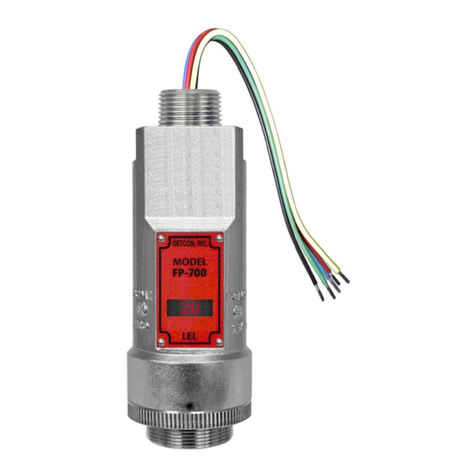
Detcon
Detcon FP-700 User manual
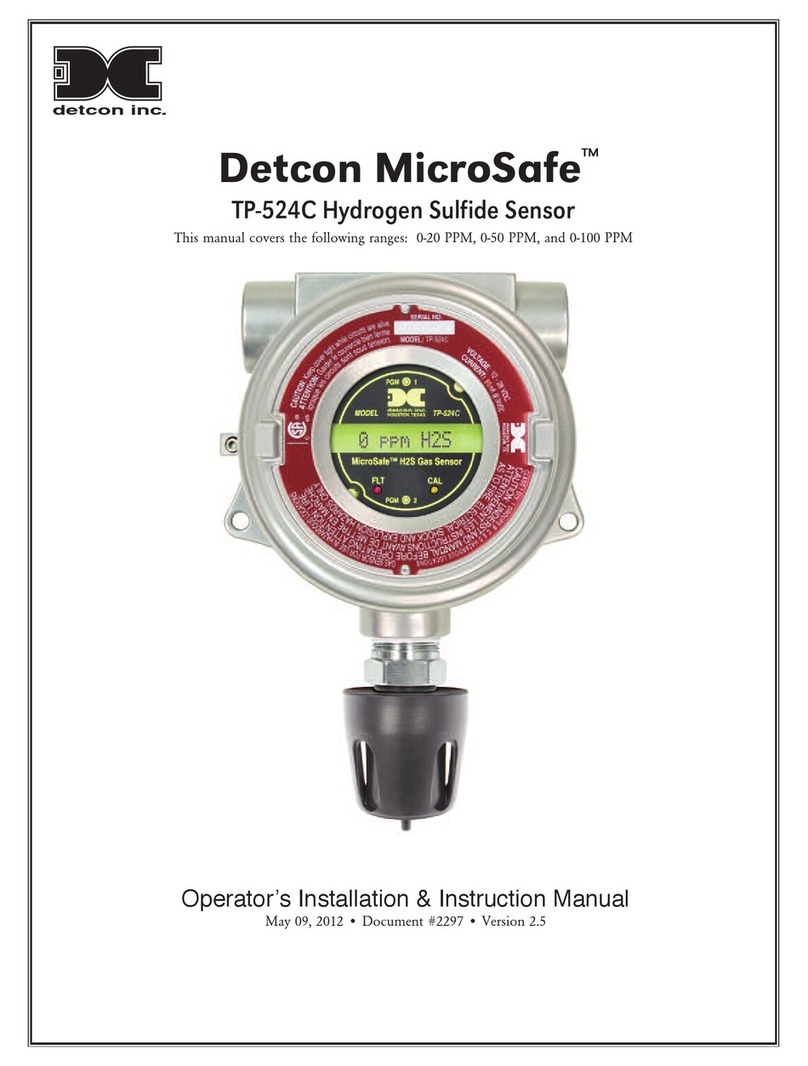
Detcon
Detcon MicroSafe TP-524C User manual
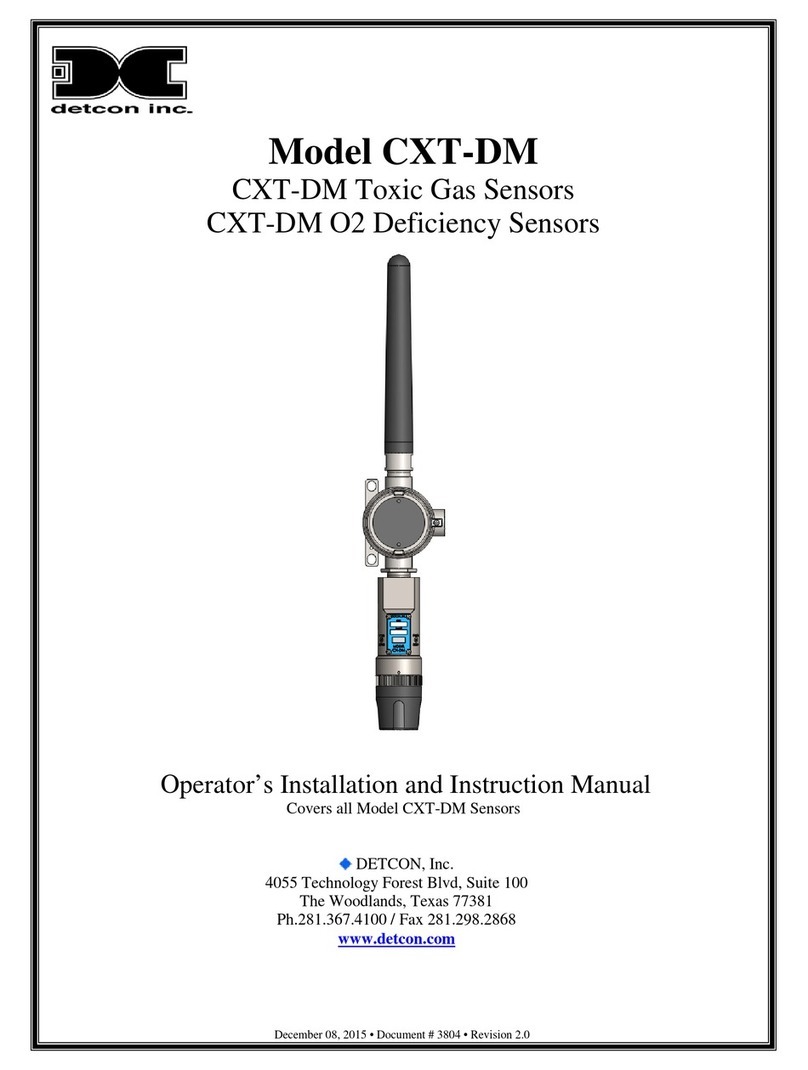
Detcon
Detcon CXT-DM User manual
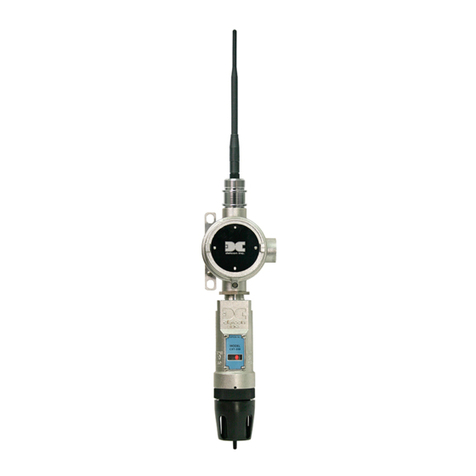
Detcon
Detcon CXT-IR User manual
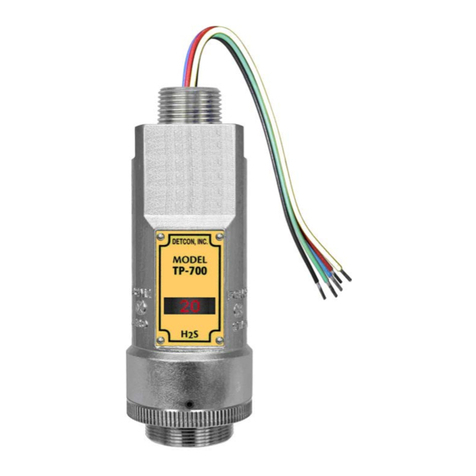
Detcon
Detcon TP-700 User manual
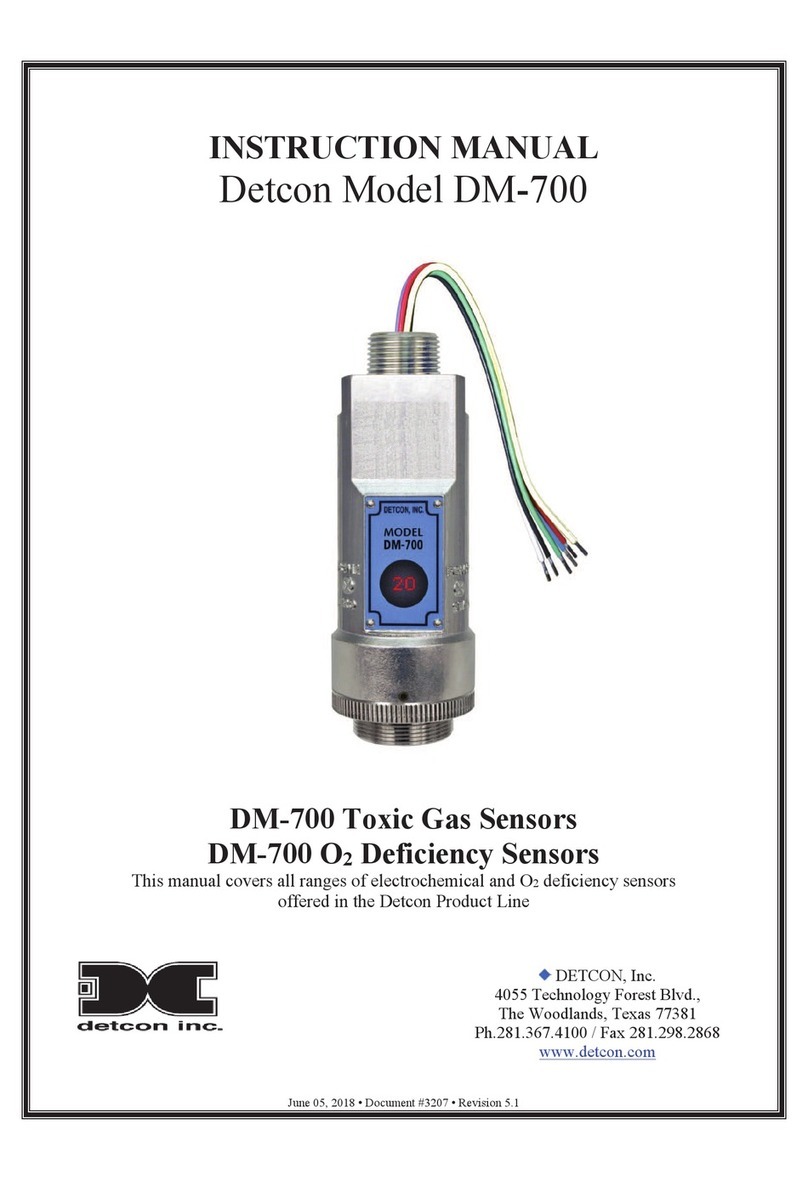
Detcon
Detcon DM-700 User manual
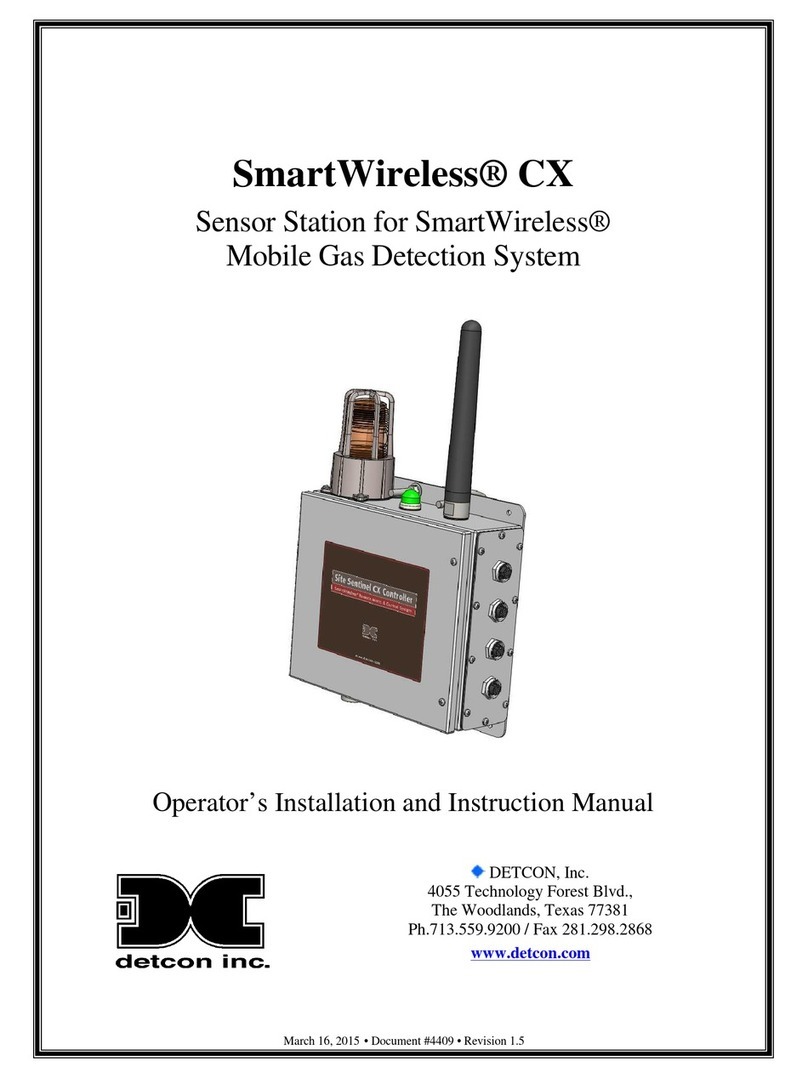
Detcon
Detcon SmartWireless CX User manual
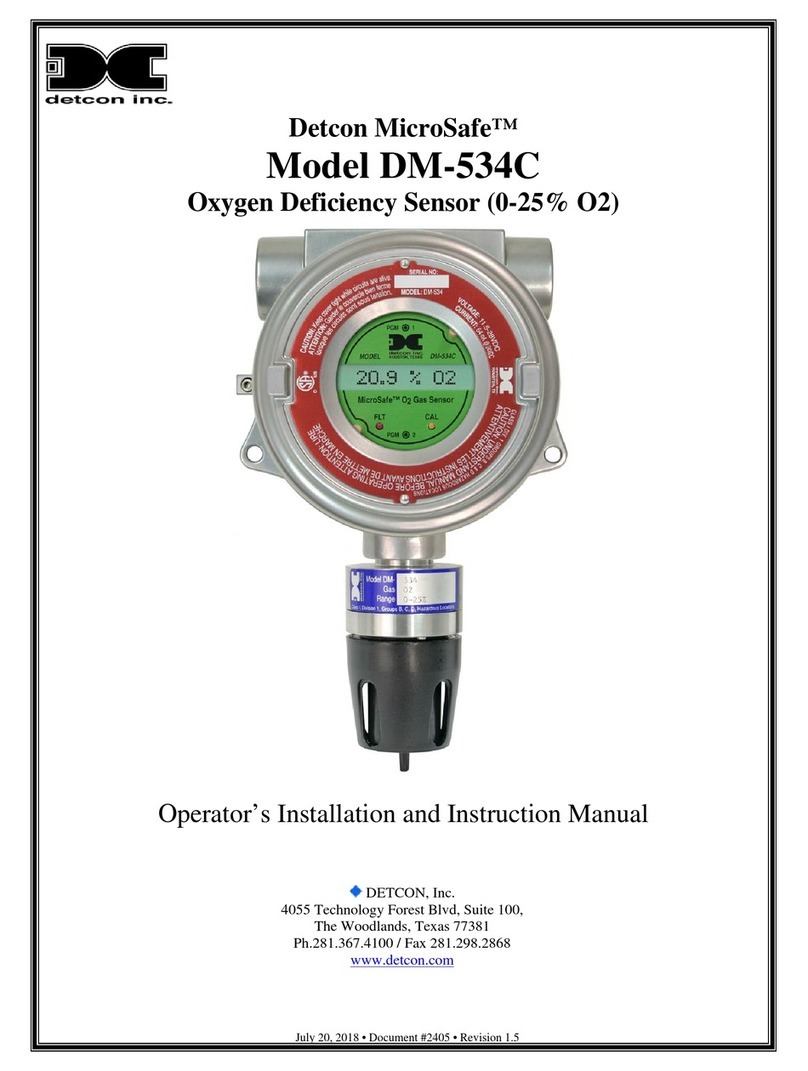
Detcon
Detcon MicroSafe DM-534C User manual
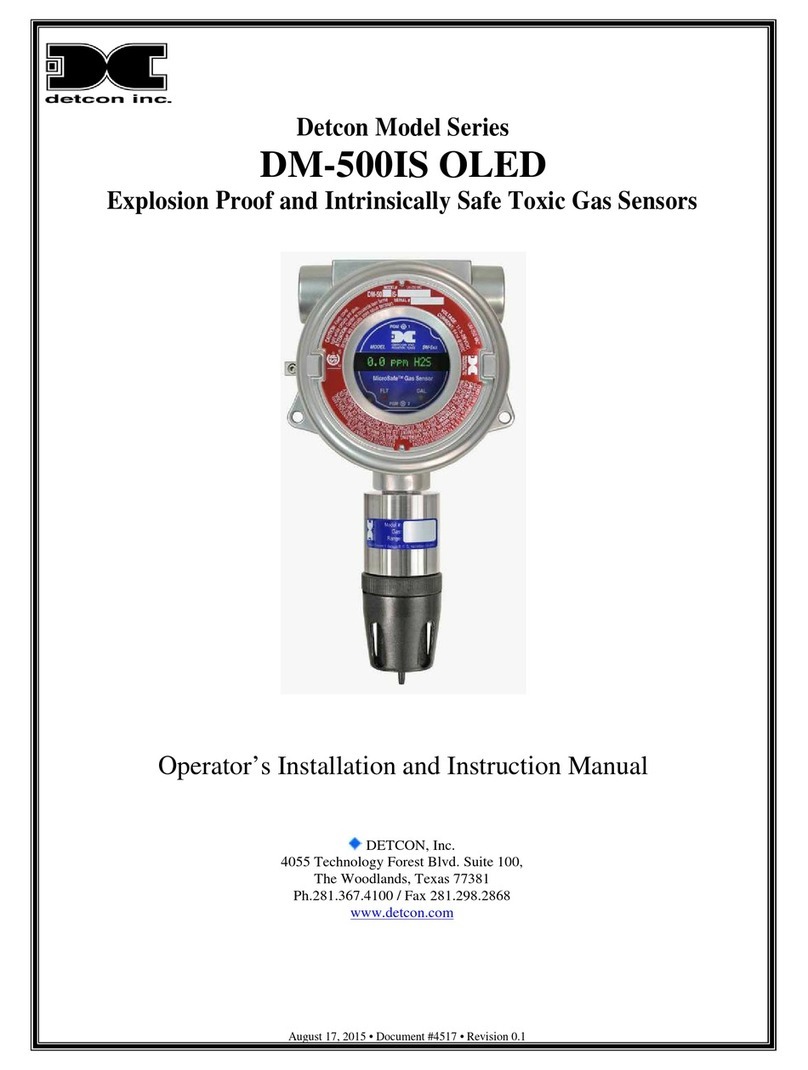
Detcon
Detcon DM-500IS OLED Series User manual
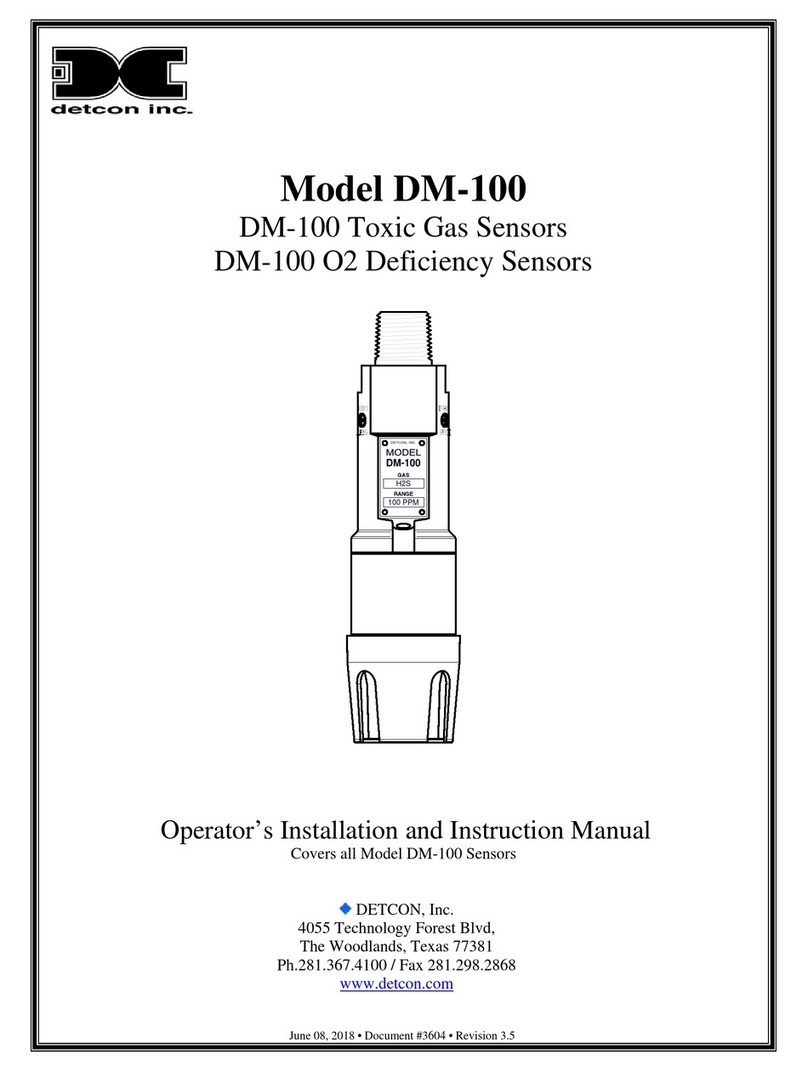
Detcon
Detcon DM-100 Series User manual
